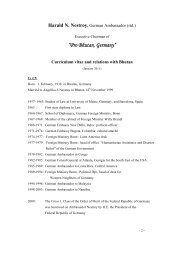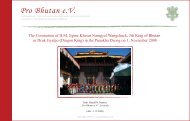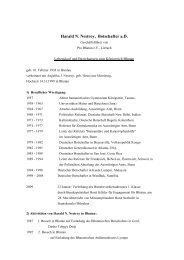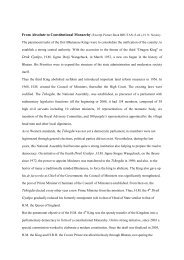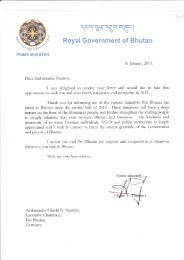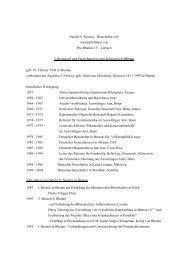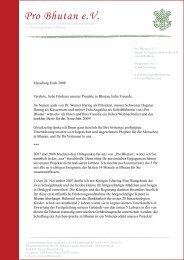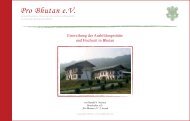“Bhutan , the Himalayan Buddhist Kingdom ... - Pro Bhutan eV
“Bhutan , the Himalayan Buddhist Kingdom ... - Pro Bhutan eV
“Bhutan , the Himalayan Buddhist Kingdom ... - Pro Bhutan eV
You also want an ePaper? Increase the reach of your titles
YUMPU automatically turns print PDFs into web optimized ePapers that Google loves.
philanthropischer Verein zur aktiven Entwicklungshilfe<br />
im Himalaja Königreich <strong>Bhutan</strong><br />
most of <strong>the</strong> important aristocratic families, Ngawang started organizing <strong>the</strong> power<br />
structure of <strong>the</strong> country: with overwhelming energy he proceeded to construct a chain<br />
of large dzongs, <strong>the</strong> monastery-castles, in <strong>the</strong> main valleys of Western <strong>Bhutan</strong> as<br />
centres of <strong>the</strong> religious and civil authority.<br />
But he had rivals. One of <strong>the</strong>m called <strong>the</strong> King of Tsang in Tibet with his troops to<br />
help oust <strong>the</strong> newcomer. In 1639 Ngawang crushed <strong>the</strong> challenger and his Tibetan<br />
allies. After this great victory he assumed <strong>the</strong> impressive title of “Shabdrung”,<br />
meaning “Precious Jewel at whose feet one prostrates” and opened <strong>the</strong> lineage of<br />
Shabdrungs in <strong>Bhutan</strong>. From now on, he was <strong>the</strong> religious and temporal ruler of<br />
<strong>Bhutan</strong>. While remaining <strong>the</strong> supreme power, he introduced a dual <strong>the</strong>ocratic system<br />
of government: a Head Abbot, <strong>the</strong> Je Kempo, administered <strong>the</strong> religious institutions,<br />
a high officer with <strong>the</strong> title Druk Desi or, as <strong>the</strong> British travellers translated, Deb Raja<br />
was vested with <strong>the</strong> civil powers. He divided <strong>the</strong> country in administrative regions,<br />
headed by a Penlop (Prince-Governor), while at local level Dzongpons executed <strong>the</strong><br />
authority, delegated from <strong>the</strong> centre. For <strong>the</strong> first time, a comprehensive system of<br />
laws was codified.<br />
Invasions by Tibetan-Mongolian troops in 1644 and 1647 were successfully repulsed<br />
and served to fur<strong>the</strong>r unite <strong>the</strong> <strong>Bhutan</strong>ese. When <strong>the</strong> Shabdrung died in 1651, <strong>the</strong><br />
major part of <strong>Bhutan</strong> was united under his authority; five years later, also Eastern<br />
<strong>Bhutan</strong> was under full control of <strong>the</strong> central government.<br />
In an intricate power game, <strong>the</strong> Shabdrung’s death was kept a state secret for more<br />
than 50 years because <strong>the</strong> temporal and religious rulers could not agree on a<br />
successor. The moment <strong>the</strong> death of <strong>the</strong> Shabdrung was made public in 1705, civil<br />
wars broke out, spurred by rival claims to <strong>the</strong> office of <strong>the</strong> Shabdrung. The unity<br />
of <strong>the</strong> country was eroded, <strong>the</strong> regional princes, <strong>the</strong> Penlops, could rule with<br />
increasing autonomy, warring against each o<strong>the</strong>r. This situation prevailed until <strong>the</strong><br />
early years of <strong>the</strong> 20th century.<br />
The decline of Moghul India at <strong>the</strong> end of <strong>the</strong> 18th century allowed <strong>Bhutan</strong> to gain<br />
almost total control of <strong>the</strong> Indian principality of Cooch Behar, its direct neighbour in<br />
<strong>the</strong> south. <strong>Bhutan</strong> had annexed and fortified <strong>the</strong> 11 duars or gateways including <strong>the</strong><br />
adjacent agricultural land, at its border with <strong>the</strong> plains of Bengal. The clash with <strong>the</strong><br />
British East India Company was pre-programmed. Soon enough, <strong>the</strong> pretender to <strong>the</strong><br />
throne of Cooch Behar (Khagenda Narayan), sought British help to oust <strong>the</strong><br />
<strong>Bhutan</strong>ese. A small British force was dispatched in December 1772 to <strong>the</strong> area and,<br />
despite heavy losses, uprooted <strong>the</strong> <strong>Bhutan</strong>ese contingent from Cooch and captured 2<br />
<strong>Bhutan</strong>ese forts in <strong>the</strong> foothills 1. Alarmed by this unexpected defeat, <strong>the</strong> Deb Raja of<br />
<strong>Bhutan</strong> ( Tshenlop Kunga Rinchen) called upon <strong>the</strong> Panchen Lama of Tibet to<br />
intercede with <strong>the</strong> Governor General Warren Hastings. The result was a peace treaty<br />
concluded between India and <strong>Bhutan</strong> in 1774 (25.4.) in Calcutta. More important,<br />
Hastings took, from now on, a serious interest in extending <strong>the</strong> British connexion<br />
beyond <strong>Bhutan</strong> to Tibet and to <strong>the</strong> fabled land of China which had remained, for all<br />
<strong>the</strong>ir efforts, beyond <strong>the</strong> Western reach.<br />
1 January and April 1773



